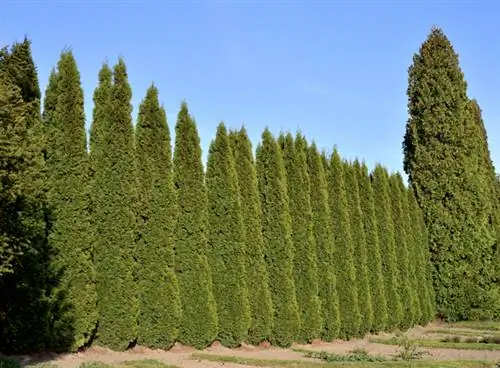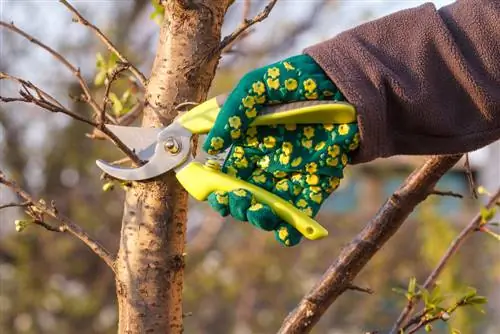- Author admin [email protected].
- Public 2023-12-16 16:46.
- Last modified 2025-01-23 11:20.
Anyone who has ever been to Tuscany knows this sight: very slender, upright growing conifers rise. planted in avenues, up to 35 meters high. This majestic sight is typical not only of the Italian region, but of large parts of the Mediterranean. Due to their large distribution area, the columnar cypresses are not called Mediterranean cypresses for nothing. The trees are also popular in our latitudes, but must be cut regularly due to their very rapid growth. So that you don't go wrong, we have created these simple instructions for you.

When and how should you prune a columnar cypress?
To properly prune a columnar cypress, choose late summer between late August and late September. Prune early in the morning, following the tree's natural shape. Do not cut the tip and always leave a few branches with needles.
Cut Tuscany cypress in late summer if possible
The ideal time to prune a columnar cypress is late summer between the end of August and the end of September. If the weather is still mild, you can still pull out the secateurs (€14.00 on Amazon) in October. In addition, cypresses should be pruned early in the morning if possible, as at this point there is no risk of drying out due to intense sunlight - the otherwise quite insensitive trees unfortunately react sensitively to this.
Don't cut back cypresses too much
Columnar cypresses should not be cut back too much, and it is also better to avoid trimming the top. Instead, you should follow the natural shape of the tree when cutting instead of forcing it into an unnatural corset. When cutting, always make sure that there are always a few branches with needles on them - the columnar cypress will sprout from these. If the tree gets too tall, generally cut away branches - but if possible not the top! In this case, the cypress would sprout in all directions and lose its typical columnar growth habit.
Pruning against brown spots
Brown spots on cypress trees are usually a sign of lack of water. If these spots appear after winter, the cause is not frostbite, but rather a lack of moisture during the cold months. Brown spots no longer disappear even with regular watering; the only countermeasure that helps is pruning accordingly. The columnar cypress will then sprout again and cover the formerly bare or brown areas with fresh green.
Tip
If severe pruning is necessary, it is recommended to spread it over several years. This gives the tree a chance to recover from the procedure and you can more easily determine the natural growth habit.






